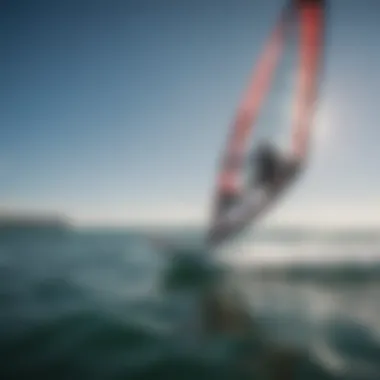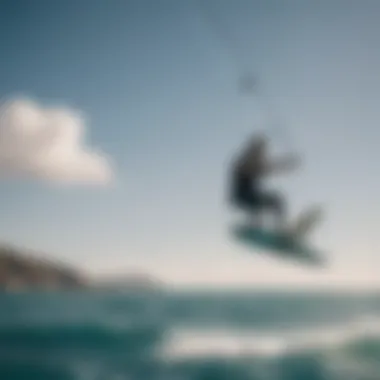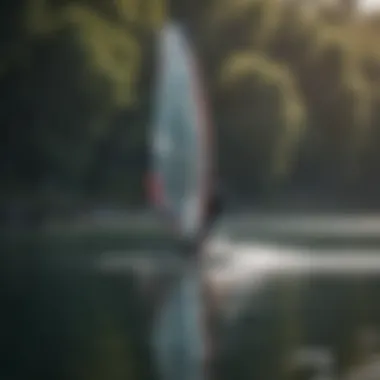Unveiling the Thrilling World of Wingfoiling: A Complete Guide for Beginners and Experts


Safety Guidelines
Navigating the unpredictable waters with finesse and caution is paramount in kiteboarding and wingfoiling. This section will enlighten riders on crucial safety protocols, enabling them to sail with confidence and resilience in the face of challenging conditions. By outlining weather considerations, emergency procedures, and equipment upkeep best practices, we aim to fortify riders with the knowledge to ensure a safe and enjoyable wingfoiling experience.
Weather Conditions
Understanding the nuances of wind dynamics, currents, tides, and weather patterns is pivotal in preempting potential risks on the water. Our insights will empower riders to assess and adapt to changing conditions swiftly, optimizing their safety and performance during each wingfoiling session.
Emergency Protocols
When unforeseen mishaps occur on the water, swift and informed actions can mitigate risks and avert untoward incidents. This subsection illuminates essential safety measures, rescue tactics, and emergency procedures, equipping riders with the know-how to navigate challenging situations proficiently and safeguard themselves and others.
Equipment Maintenance
Preserving the longevity and performance of your kiteboarding equipment is non-negotiable for a seamless and secure riding experience. By emphasizing routine equipment checks, maintenance rituals, and safety gear inspections, riders can uphold the integrity of their gear and embark on each wingfoiling adventure with peace of mind.
Introduction to Wingfoiling
Wingfoiling is an exhilarating water sport that has rapidly gained popularity among adventure enthusiasts and watersports aficionados. This section serves as a foundational piece in our comprehensive guide to wingfoiling, shedding light on the essence of this dynamic activity. Understanding wingfoiling is not just about riding the waves; it entails a fusion of skills from kitesurfing, windsurfing, and foiling techniques. Whether you are a beginner eager to embark on a new aquatic adventure or a seasoned rider seeking to refine your skill set, mastering the basics of wingfoiling is paramount to your success on the water.
What is Wingfoiling?
Definition and Origins
Delving into the roots of wingfoiling unveils a thrilling pastime with a rich history that dates back to the blend of kitesurfing, windsurfing, and foiling innovations. The high-octane appeal of wingfoiling lies in its ability to harness wind power through a handheld wing while gliding effortlessly on a hydrofoil board. This harmonious convergence of elements sets wingfoiling apart, offering riders a unique sensation of flight over the water. The origin of wingfoiling can be traced back to visionary water sports enthusiasts who sought to blend the best aspects of various disciplines into a fluid and captivating experience for riders worldwide.
Key Components
At the core of wingfoiling lie two key components essential for a successful ride - the wing and the hydrofoil board. The wing, akin to a kite but handheld, acts as the primary source of propulsion, allowing riders to catch the wind and sustain flight. On the other hand, the hydrofoil board, equipped with a foil that extends below the surface, enables riders to elevate above the water and experience minimal drag for a smooth and efficient glide. These components work in harmony, requiring a delicate balance of skill, technique, and coordination from the rider to achieve a seamless and exhilarating wingfoiling experience.
Differences from Kitesurfing and Windsurfing
Sail Design
Distinguishing itself from traditional kitesurfing and windsurfing, wingfoiling entails a unique approach to sail design that emphasizes portability and minimalism. The compact and collapsible nature of wing sails allows for easy transport and setup, making wingfoiling a versatile choice for riders seeking a hassle-free water sports experience. The pivotal role of sail design in wingfoiling lies in its adaptability to varying wind conditions, providing riders with enhanced control and maneuverability on the water.


Board Characteristics
The design of a wingfoiling board sets it apart from conventional kitesurfing and windsurfing boards, featuring a specialized hydrofoil that enables riders to lift above the water's surface. These hydrofoil boards are crafted for optimal lift and stability, facilitating smooth rides and precise maneuvering for riders of all skill levels. Board characteristics play a crucial role in the overall wingfoiling experience, dictating the rider's ability to navigate choppy waters, perform aerial maneuvers, and glide seamlessly across the water's surface.
Getting Started with Wingfoiling
Wingfoiling, a burgeoning water sport that merges elements from kitesurfing, windsurfing, and foiling, requires a solid foundation for beginners. Mastering the art of wingfoiling starts with understanding the essential gear required. From selecting the appropriate wing to choosing the right foiling board, each decision contributes significantly to the overall experience. Proper guidance on equipment is crucial for a seamless transition into the world of wingfoiling.
Essential Gear for Wingfoiling
Wing Selection
When embarking on the wingfoiling journey, selecting the right wing is paramount. The wing's design plays a fundamental role in harnessing wind power efficiently. A key characteristic to consider in wing selection is its size relative to the rider's weight and skill level. Choosing the correct wing size ensures better control and stability during maneuvers. Additionally, the maneuverability and lift capacity of the wing are vital aspects to enhance the overall wingfoiling experience. While larger wings provide more lift, they might be challenging to handle for beginners. Therefore, finding a balance between size and control is essential for optimal performance.
Foiling Board Options
The choice of a foiling board significantly impacts the rider's experience on the water. When exploring foiling board options, stability and maneuverability are crucial factors to consider. A key characteristic of foiling boards is their hydrodynamic design, which enables riders to glide effortlessly over the water's surface. Selecting a board that offers stability while maintaining lightness is favorable for beginners. The unique feature of foiling boards lies in their ability to reduce drag, allowing riders to achieve higher speeds with less effort. However, this increased efficiency may come at the cost of maneuverability in certain models. Understanding the advantages and disadvantages of different foiling board options is essential to tailor the board choice to individual preferences and skill levels.
Safety Precautions and Guidelines
Understanding Wind Conditions
Wind conditions play a crucial role in wingfoiling safety. Understanding the behavior of wind patterns and their impact on water currents is essential for a safe and enjoyable experience. Knowledge of wind direction, speed, and gusts helps riders anticipate challenges and adjust their technique accordingly. A key characteristic of wind awareness is the ability to read weather forecasts accurately. By interpreting meteorological data effectively, riders can make informed decisions about when and where to practice wingfoiling. Embracing this aspect not only enhances safety but also maximizes the enjoyment of the sport.
Emergency Procedures
In any water sport, being prepared for emergencies is paramount. Having a clear set of emergency procedures in place can prevent potential risks and mitigate dangers on the water. A key characteristic of emergency protocols is swift and coordinated action in response to unforeseen circumstances. Establishing communication channels and signals with fellow riders enhances group safety and facilitates rescue operations if needed. The unique feature of emergency procedures lies in their role in promoting a culture of safety and responsibility among wingfoilers. While addressing potential risks is essential, maintaining a proactive approach towards emergencies ensures a secure environment for all participants.
Basic Techniques for Beginners
Launching and Landing
Launching and landing are fundamental skills that all wingfoilers must master. Proper technique in these areas ensures a smooth start and finish to every session. A key characteristic of launching involves understanding wind direction and positioning the wing appropriately for takeoff. Skillful execution of launching techniques minimizes the risk of crashes and ensures a stable ascent into the air. On the other hand, landing techniques focus on controlled descents and safe touchdown on the water's surface. Mastering the art of landing enhances rider safety and prolongs the lifespan of equipment. The unique feature of launching and landing lies in their role as foundational skills that set the stage for more advanced maneuvers.
Balancing on the Board


Balancing on the board is a core skill that underpins all wingfoiling maneuvers. Achieving stability and control while riding the board is essential for mastering advanced techniques. A key characteristic of balancing involves finding the rider's center of gravity and adjusting body positioning accordingly. Maintaining balance in various wind conditions and wave patterns challenges riders to hone their skills continuously. The unique feature of balancing on the board is its direct impact on maneuverability and speed. By developing solid balancing techniques, riders can unlock new possibilities in their wingfoiling journey.
Mastering Advanced Wingfoiling Skills
Wingfoiling, like any sport, requires dedication and proficiency to master. In this section, we delve into the importance of mastering advanced skills in wingfoiling, outlining the specific elements, benefits, and considerations that come with this level of expertise. Advanced wingfoiling skills not only elevate the rider's performance but also open up a realm of thrilling maneuvers and techniques that truly showcase the beauty of this water sport.
Advanced Maneuvers and Tricks
Jibing and Tacking
Jibing and tacking are fundamental maneuvers in wingfoiling that significantly contribute to the rider's ability to navigate effectively on the water. Understanding the nuances of jibing and tacking is crucial for mastering advanced wingfoiling skills. Their key characteristic lies in the seamless transition they allow the rider to make while changing directions, crucial for fluid and controlled movement on the board. Jibing and tacking are popular choices for riders looking to enhance their agility and maneuverability on the water, offering a dynamic way to navigate varying wind conditions. These maneuvers are unique in their ability to provide riders with increased control over their foiling experience, enabling them to adjust their course with precision and finesse.
Aerial Foiling
Aerial foiling is an exhilarating aspect of wingfoiling that pushes the boundaries of traditional maneuvers to new heights - quite literally. This advanced technique involves lifting the foil out of the water, experiencing flight-like sensations as you soar above the waves. Aerial foiling's key characteristic lies in the adrenaline rush it provides, elevating the rider's experience to new levels of excitement and challenge. It is a popular choice among experienced wingfoilers seeking to add a thrill factor to their sessions. The unique feature of aerial foiling is the sense of freedom and weightlessness it offers, allowing riders to explore the skies above the water while harnessing the power of the wind. While demanding a high level of skill and control, aerial foiling rewards riders with unmatched thrills and a profound sense of accomplishment.
Optimizing Performance
Foiling in Different Conditions
Adapting to various wind and water conditions is essential for optimizing performance in wingfoiling. Foiling in different conditions allows riders to fine-tune their skills and techniques to suit changing environments, contributing to a well-rounded and adaptable riding style. The key characteristic of foiling in different conditions is the resilience and versatility it cultivates in riders, preparing them to handle a range of challenges on the water. This adaptability makes it a popular choice for wingfoilers looking to expand their capabilities and ride comfortably in diverse settings. The unique feature of foiling in different conditions is the insight it offers into the intricate relationship between rider, equipment, and natural elements, providing valuable learning experiences and fostering growth in skill and confidence.
Speed Control Techniques
Mastering speed control in wingfoiling is paramount for a safe and exhilarating riding experience. Speed control techniques enable riders to regulate their pace effectively, ensuring optimal balance and stability on the board. The key characteristic of speed control techniques is their ability to empower riders to harness the wind's energy efficiently and maintain control over their foiling speed. This aspect is a popular choice for wingfoilers seeking to enhance their precision and finesse while riding, allowing them to adjust their speed with ease and confidence. The unique feature of speed control techniques is the sense of mastery and control they bring to the rider, enhancing the overall riding experience and opening up possibilities for exploring different facets of wingfoiling at varying speeds.
Exploring Wingfoiling Destinations
Exploring various wingfoiling destinations is a pivotal aspect in understanding the breadth and diversity this exhilarating water sport offers. The selection of the perfect location can significantly impact the experience and skill development of riders. Different destinations present unique challenges and opportunities, making it essential for enthusiasts to explore a range of spots to enrich their wingfoiling journey.
Top Global Spots for Wingfoiling
Hawaii
Hawaii stands as a beacon for wingfoilers worldwide, revered for its consistent wind patterns and idyllic waters. Its warm tropical climate and stunning beaches provide the perfect setting for an unparalleled wingfoiling experience. The rugged coastlines offer dynamic conditions for riders of all levels to hone their skills, from novices to advanced practitioners. Additionally, Hawaii's rich cultural heritage and vibrant local community add a captivating dimension to the overall wingfoiling experience.


Tarifa, Spain
Tarifa, Spain, emerges as a hotspot for wingfoilers seeking a blend of adventure and relaxation. Known for its strong winds, Tarifa offers an adrenaline-packed environment conducive to high-speed rides and thrilling maneuvers. The picturesque views of the Mediterranean Sea and the laid-back Spanish lifestyle create a unique ambiance that draws riders from around the globe. While the wind conditions in Tarifa can be quite challenging at times, they provide an excellent opportunity for riders to push their limits and enhance their skills.
Mauritius
Mauritius is a paradisiacal destination that caters to wingfoilers seeking a blend of luxury and adventure. Its crystal-clear turquoise waters and gentle breezes create a peaceful setting for riders to enjoy long foiling sessions against the backdrop of breathtaking landscapes. The island's diverse coastlines offer a range of conditions, from tranquil lagoons to powerful surf breaks, catering to riders of varying skill levels. While Mauritius' remote location can pose logistical challenges, the unparalleled beauty and seclusion it provides make every wingfoiling session a truly unforgettable experience.
Choosing the Right Destination for Your Skill Level
Beginner-Friendly Options
For beginners seeking to embark on their wingfoiling journey, choosing the right destination is crucial for a positive and progressive experience. Beginner-friendly options typically offer sheltered waters, consistent winds, and professional instruction to support newcomers in mastering the basics of wingfoiling. These destinations focus on safety and gradual skill development, ensuring that novice riders feel comfortable and confident as they navigate their early experiences in the sport.
Challenges for Experienced Riders
Experienced wingfoilers looking to test their limits and refine their techniques often seek destinations that present unique challenges and demanding conditions. These spots provide experienced riders with opportunities to explore advanced maneuvers, tackle diverse wind and wave patterns, and interact with a community of like-minded individuals who share their passion for the sport. While these destinations may require more significant skill levels and experience, they offer seasoned riders the chance to push boundaries and elevate their wingfoiling abilities to new heights.
Embracing the Wingfoiling Lifestyle
Embracing the Wingfoiling Lifestyle is a pivotal aspect of the comprehensive guide on Wingfoiling. This section delves into the cultural and communal elements surrounding Wingfoiling, emphasizing the significance of adopting this lifestyle beyond the sport itself. Engaging with the Wingfoiling lifestyle entails more than just mastering skills; it involves becoming part of a vibrant community that shares a passion for wind and water sports. Understanding the lifestyle encompasses connecting with like-minded individuals, participating in events, and promoting a collective love for the sport.
Community and Events
Local Wingfoiling Groups
Local Wingfoiling Groups play a crucial role in nurturing camaraderie and skill development within the sport. These groups serve as hubs for enthusiasts to exchange knowledge, share experiences, and organize local outings. One distinct characteristic of Local Wingfoiling Groups is their commitment to fostering a supportive environment for both new learners and seasoned riders. Joining such groups offers a platform for novices to learn from experts while providing experienced riders with opportunities for continuous improvement. Despite occasional challenges, being part of a Local Wingfoiling Group significantly enhances one's overall Wingfoiling experience.
Major Competitions
Participation in Major Competitions elevates the Wingfoiling experience to a competitive level while showcasing top-tier skills and innovation in the sport. These competitions attract elite athletes and spectators worldwide, offering a platform to witness groundbreaking maneuvers and techniques. The key characteristic of Major Competitions lies in their ability to push the boundaries of Wingfoiling, inspiring advancements in gear, performance, and style. While the pressure of competition may present challenges, the exposure gained and the spirit of sportsmanship fostered through these events undeniably contribute to the growth and prestige of Wingfoiling.
Environmental Awareness and Conservation
Sustainable Practices
Embracing Sustainable Practices is a cornerstone of responsible Wingfoiling, emphasizing the importance of minimizing environmental impact and preserving natural resources. Sustainable Practices involve techniques such as minimizing plastic usage, supporting eco-friendly products, and promoting clean energy solutions within the Wingfoiling community. The key characteristic of Sustainable Practices is their long-term positive effects on the environment, promoting sustainable behaviors that benefit both present and future generations of Wingfoilers. While integrating these practices might require initial adjustments, the lasting benefits they offer to the ecosystem make them a paramount choice for any Wingfoiler.
Protecting Marine Ecosystems
Protecting Marine Ecosystems is a crucial endeavor within the Wingfoiling community, aiming to safeguard the delicate balance of marine life and habitats. This aspect emphasizes the significance of responsible practices, such as avoiding sensitive areas, reducing pollution, and supporting marine conservation efforts. The unique feature of Protecting Marine Ecosystems lies in its direct impact on the health and sustainability of marine environments, highlighting the interconnectedness between Wingfoilers and the oceans they traverse. Despite challenges like enforcement and compliance, prioritizing the protection of marine ecosystems remains non-negotiable for conscientious Wingfoilers.







